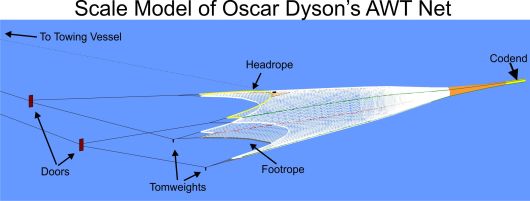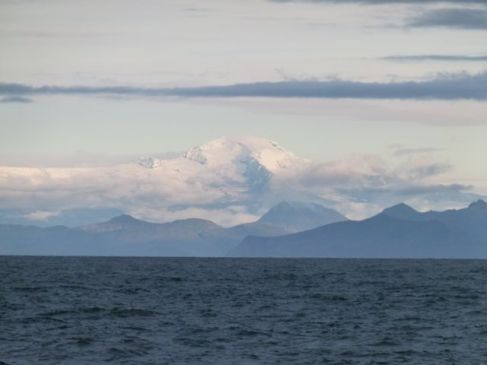NOAA Teacher at Sea
Lynn M. Kurth
Aboard NOAA Ship Rainier
June 20-July 1, 2016
Mission: Hydrographic Survey
Geographical area of cruise: Latitude: N 57˚23 Longitude: W 153˚20 (North Coast of Kodiak Island)
Date: June 26, 2016
Weather Data from the Bridge:
Sky: Fog
Visibility: 1 Nautical Mile
Wind Direction: 085
Wind Speed: 12 Knots
Sea Wave Height: –
Sea Water Temperature: 12.2° C (54° F)
Dry Temperature: 12.6° C (54.7° F)
Barometric (Air) Pressure: 1008.6 mb
Science and Technology Log
As I was looking up at the stars over the ship one evening, I was thinking about the study of space and the 1980’s Teacher in Space program. It’s difficult to believe that as of this past January it has been thirty years since the Space Shuttle Challenger disaster, which took the life of educator Christa McAuliffe and six other astronauts. Christa had been selected to become the first teacher in space, which offers such opportunity to learn and grow. I admire Christa McAuliffe because of this and the fact that she recognized that the study of space offers the opportunity for discovery, innovation and investigation.
I love being a Teacher at Sea because the ocean is similar to space in that it is largely unexplored and offers the chance to discover, innovate and investigate. In fact, less than 5% of earth’s ocean has been explored even though new technologies have expanded our ability to explore. Scientists like those I am working with on the Rainier use a variety of this new technology such as satellites, complex computer programs, and multi beam sonar to explore and carry out their hydrographic work. Over the past week, I have been fortunate to work with these scientists in Uganik Bay and gain a better understanding of how they use these technologies in their work.
Before the surveying work using the multi beam sonar system can begin, a small crew is sent off the Rainier in a skiff, a shallow flat-bottomed open boat, to complete near shore work. During this work, the crew on the skiff meticulously examines the features of the coastline while comparing what they see to any available charts and other sources of information about the area. The depth of Uganik Bay was last surveyed and charted in 1908 but the area does have some additional charting of shoreline features documented throughout the years via aerial photography and information shared by local mariners. The skiff used for the near shore work is equipped with a GPS (global positioning system) unit and a computer program which continually maps where it travels. The skiff moves slowly along the shoreline while circling rocks and other features (reefs, islands, kelp beds, fishing gear) in order to accurately determine their size and location. The scientists record all of their findings on a sheet illustrating the area they are working in and enter the revisions into a computer program when they return to the Rainier. These revisions frequently include adding features not previously documented, modifying information on existing features or suggesting possible features to be eliminated when they are not found and verified.
For example, one of the days while I was working with a crew on a skiff, part of our work involved verifying whether or not a series of rocks existed where they had been previously charted. Oddly enough, when looking at the chart the formation of rocks looked like a giant left footprint. This particular feature on the chart, was flagged for us to investigate and verify because each of the rocks that made up “the little toes” seemed to be too equally spaced to be natural features. When we examined the area we found that there was only one rock, “the big toe”, at the top of the formation vs. a total of five. The suggested updates to this feature were supported with the documentation of photographs and measurements. In other words, the scientists suggested that the final revisions completed by NOAA staff in Seattle would include the “amputation” of the four “little toes” from the charts.
All Aboard!
I have really enjoyed chatting with the people on board the Rainier because they have interesting stories to share and are happy to share them. Erin Earley, member of the engine utility crew, was one of those people who graciously gave me some of her time for an interview.
Tell us a little about yourself:
I’m Erin Earley from Sacramento, California and was a social worker prior to working for NOAA (National Oceanic Atmospheric Administration). I enjoy water color painting, creating multi-medium sculptures, and anything to do with designing gardens. And I love dogs, Shelties in particular.
How did you discover NOAA and what do you love the most about your job with NOAA?:
As a social worker I had a couple of young adults in the child protection system who wanted to find a different career. When looking at career options for them I came across a maritime program for youth in Sacramento that seemed to meet their needs. So, I went to a parent night to learn more about the program and when I heard about the rate of pay and opportunity to travel I asked if they were considering an option for adults to join the program. They said that they were and I registered for the program and began with the AB (able bodied seaman) program for deck work but after watching the Deadliest Catch I decided that wasn’t for me. So, I decided to complete the engineering program to be qualified for engine room work. The course work included survival work, emergency ship repair work and fire fighting skills.
I love my job with NOAA because for the most part I’m working with a small group of people, we all know our duties, and we all help each other out. I enjoy seeing jobs get completed and things getting fixed. And, the most important reason I love my job is that I don’t have to drive to work and dress up. I come from Sacramento, and here I don’t have to wait for traffic coming across town and wait at Starbucks for an hour. On a ship you become a minimalist, you learn what is important and what is not. I love meeting new people, trying new foods and seeing new things!
What are your primary responsibilities when working on the ship?
My primary responsibilities at sea include monitoring the oil levels of the equipment, making sure that everything is running properly, reporting to the engineer anything that might be a problem, making sure the bow thruster has proper fluids, and making sure there’s no excess water in any of the places. We’re floating on a huge ocean and we want to make sure none of it’s coming in!
What kind of background and/or education do you need to have this job?
It would help to go to a maritime school and a lot of major coastal cities have these schools that offer these programs. If you want a four year college education you could go to a maritime academy (San Francisco, New York and Baltimore ) to get a degree in mechanical engineering and then you could work on a ship or on the shore side at a port. If you don’t want to go to a four year college you can still work in engineering but you would have to take certification courses and work your way up. I think for a young person the adventure of working for NOAA is fun but you should always have a plan as far as where you might want to go. Keep your options open!
Did You Know?
The Rainier:
- has 26 fuel tanks
- uses 500 gallons of fuel a day while at anchor
- uses 100 gallons of fuel each hour while underway (2400 gallons/day)
- goes through approximately 50 lbs of beef and 30 lbs of chicken each week
- uses 8 different kinds of milk (lactose free, soy, almond, cashew, 1%, 2%, whole, and skim)



























































